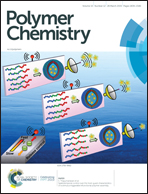Synthesis of novel conjugated polymers based on benzo[1,2-d:4,5-d′]-bis([1,2,3]triazole) for applications in organic field-effect transistors†
Abstract
Novel donor–acceptor (D–A) conjugated polymers based on 4,8-bis(5-bromothiophen-2-yl)-2,6-bis(2-octyldodecyl)-2H-benzo[1,2-d:4,5-d′]- bis([1,2,3]triazole)-6-ium-5-ide (BTBBTa) combined with three different electron-donating monomers bithiophene (BT), thieno[3,2-b]thiophene (TT), (E)-2-[2-(thiophen-2yl)vinyl]thiophene (TVT) were synthesized. By replacing the sulfur atoms on benzobisthiadiazole with nitrogen atoms, benzobistriazole (BBTa) can possess alkyl chains on the central nitrogen atoms rather than on the thiophene rings along the polymer chain, which can reduce the steric hindrance between neighboring monomers and increase the planarity of polymers. The optical, thermal and electrochemical properties of the polymers were characterized, respectively. DFT calculations were used to calculate the optimized geometries of polymer backbones. The thin film microstructures of the polymers were characterized by using GIWAXS and AFM. In these novel polymers, PBTBBTa-BT displayed the highest hole mobility of 0.21 cm2 V−1 s−1.
![Graphical abstract: Synthesis of novel conjugated polymers based on benzo[1,2-d:4,5-d′]-bis([1,2,3]triazole) for applications in organic field-effect transistors](/en/Image/Get?imageInfo.ImageType=GA&imageInfo.ImageIdentifier.ManuscriptID=C8PY01526K&imageInfo.ImageIdentifier.Year=2019)


 Please wait while we load your content...
Please wait while we load your content...